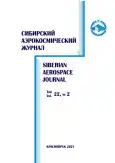Постановка задачи оптимизации структуры аппаратно-программного комплекса системы управления реального времени
- Авторы: Ефимов С.Н.1, Терсков В.А.1, Серикова О.Ю.2, Попова А.В.1
-
Учреждения:
- Сибирский государственный университет науки и технологий имени академика М. Ф. Решетнева
- Красноярский институт железнодорожного транспорта – филиал Иркутского государственного университета путей сообщения
- Выпуск: Том 22, № 2 (2021)
- Страницы: 218-226
- Раздел: Раздел 1. Информатика, вычислительная техника и управление
- Статья опубликована: 23.06.2021
- URL: https://journals.eco-vector.com/2712-8970/article/view/562871
- DOI: https://doi.org/10.31772/2712-8970-2021-22-2-218-226
- ID: 562871
Цитировать
Аннотация
В статье приведена постановка задачи оптимизации структуры аппаратно-программных комплексов, предназначенных для систем управления реального времени, применяемых, в том числе, в ракетно-космической отрасли. Кроме того, изучены особенности данной задачи, влияющие на выбор методов оптимизации. Делается вывод, что данная задача может быть эффективно решена с использованием эволюционных методов оптимизации.
Существующие модели производительности позволяют определять минимальную аппаратную конфигурацию многопроцессорного вычислительного комплекса. Предложенный в данной статье подход позволяет находить конфигурации, обладающие аппаратной избыточностью (по сравнению с минимальной конфигурацией), но, за счёт этого, имеющие большую вероятность нахождения в состояниях, обеспечивающих производительность, достаточную для достижения целей функционирования проектируемой системы управления реального времени. Описанный подход является более гибким, чем простое дублирование всех аппаратных компонентов минимальной конфигурации, что может быть использовано для уменьшения затрат на создание и эксплуатацию проектируемой системы управления.
Предложенная модель может быть использована для оптимизации производительности многопроцессорных аппаратно-программных комплексов систем управления реального времени. При этом нужно учитывать, что ресурсы, выделенные на создание и эксплуатацию аппаратнопрограммного комплекса, всегда ограничены. Поэтому целесообразно рассматривать задачу оптимизации производительности как многокритериальную: одним критерием будет производительность, а другим – затраты на создание аппаратно-программного комплекса.
Об авторах
Сергей Николаевич Ефимов
Сибирский государственный университет науки и технологий имени академика М. Ф. Решетнева
Автор, ответственный за переписку.
Email: efimov@bk.ru
кандидат технических наук, доцент, доцент кафедры информационноуправляющих систем
Россия, 660037, г. Красноярск, проспект имени газеты «Красноярский рабочий», 31Виталий Анатольевич Терсков
Сибирский государственный университет науки и технологий имени академика М. Ф. Решетнева
Email: terskovva@mail.ru
доктор технических наук, профессор, профессор кафедры информационно-управляющих систем
Россия, 660037, г. Красноярск, проспект имени газеты «Красноярский рабочий», 31Олеся Юрьевна Серикова
Красноярский институт железнодорожного транспорта – филиал Иркутского государственного университета путей сообщения
Email: olesyaserik@mail.ru
аспирант
Россия, 660028, г. Красноярск, ул. Новая Заря, 2Анастасия Валерьевна Попова
Сибирский государственный университет науки и технологий имени академика М. Ф. Решетнева
Email: nasty.popowa@yandex.ru
магистрант
Россия, 660037, г. Красноярск, проспект имени газеты «Красноярский рабочий», 31Список литературы
- Васильев В. А., Легков К. Е., Левко И. В. Системы реального времени и области их применения // Информация и космос. 2016. № 3. C. 68–70.
- Buttazzo G. Hard Real-Time Computing Systems: Predictable Scheduling Algorithms and Applications. New York, NY, Springer. 2011.
- Sutter H. The free lunch is over: A fundamental turn toward concurrency in software // Dr. Dobb’s Journal. 2005. 30(3) [Электронный ресурс]. URL: http://www.gotw.ca/publications/ concurrency-ddj.htm (дата обращения: 11.03.2021).
- Liu Wang, Xiao Li, Shanghong Li Research on the Performance of Robot Multiprocessor Control System Based on BS Structure Digital Media // Microprocessors and Microsystems. 2020. Vol. 75. P. 103067.
- Ефимов С. Н., Терсков В. А. Реконфигурируемые вычислительные системы обработки информации и управления. Красноярск : КрИЖТ ИрГУПС, 2013. 249 с.
- Костров Б. В., Мартышкин А. И. Исследование структурной организации и оценка производительности многопроцессорных вычислительных систем с общей шиной // Известия Тульского гос. ун-та. Технич. науки. 2018. Вып. 2. С. 152–162.
- Вентцель А. Д. Курс теории случайных процессов. М. : Наука, 1996. 400 с.
- Бахвалов Н. С., Жидков Н. П., Кобельков Г. М. Численные методы. М. : БИНОМ. Лаборатория знаний, 2004. 636 с.
- Липаев В. В. Экономика производства программных продуктов. М. : СИНТЕГ, 2011. 358 с.
- Использование метода роя частиц для формирования состава мультиверсионного программного обеспечения / И. В. Ковалев, Е. В. Соловьев, Д. И. Ковалев и др. // Приборы и системы. Управление, контроль, диагностика. 2013. № 3. С. 1–6.
- К вопросу реализации мультиверсионной среды исполнения бортового программного обеспечения автономных беспилотных объектов средствами операционной системы реального времени
- / И. В. Ковалев, В. В. Лосев, М. В. Сарамуд и др. // Вестник СибГАУ. 2017. Т. 18, № 1. С. 58–61.
- Efimov S. N., Tyapkin V. N., Dmitriev D. D., Terskov V. A. Methods of Assessing the Characteristics of the Multiprocessor Computer System Adaptation Unit // Journal of Siberian Federal University. Mathematics & Physics. 2016. No. 9 (3). P. 288–295.
- Глазова М. А. Модель COCOMO II: анализ и пути усовершенствования // Экономика, статистика и информатика. 2008. № 3. С. 63–67.
- Шеенок Д. А., Кукарцев В. В. Прогнозирование стоимости разработки систем с программной избыточностью // Известия Волгоградского гос. технич. ун-та. 2013. № 14 (117). С. 101–105.
- Тархов Д. А., Радченко Д. С. Распределенные алгоритмы оптимизации // Современные информационные технологии и ИТ-образование. 2015. Том 11, № 2. С. 404–408.
- Semenkina O. E., Popov E. A., Semenkin E. S. Cooperative self-configuring nature-inspired algorithm for a scheduling problem // IOP Conference Series: Materials Science and Engineering. 2021. P. 12080.
- Goldberg D. E. Genetic algorithms in search, optimization, and machine learning, Reading, MA: Addison-Wesley Professional. 1989.
- Полякова А. С., Липинский Л. В., Семенкин Е. С. Автоматизированная система формирования состава коллектива многокритериальным генетическим алгоритмом. М. : Роспатент. 2020. № государственной регистрации программы для ЭВМ RU 2020663770 от 22.10.2020.
Дополнительные файлы







